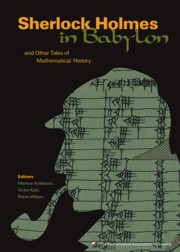Book contents
- Frontmatter
- Introduction
- Contents
- Ancient Mathematics
- Medieval and Renaissance Mathematics
- The Seventeenth Century
- Foreword
- An Application of Geography to Mathematics: History of the Integral of the Secant
- Some Historical Notes on the Cycloid
- Descartes and Problem-Solving
- René Descartes' Curve-Drawing Devices: Experiments in the Relations Between Mechanical Motion and Symbolic Language
- Certain Mathematical Achievements of James Gregory
- The Changing Concept of Change: The Derivative from Fermat to Weierstrass
- The Crooked Made Straight: Roberval and Newton on Tangents
- On the Discovery of the Logarithmic Series and Its Development in England up to Cotes
- Isaac Newton: Man, Myth, and Mathematics
- Reading the Master: Newton and the Birth of Celestial Mechanics
- Newton as an Originator of Polar Coordinates
- Newton's Method for Resolving Affected Equations
- A Contribution of Leibniz to the History of Complex Numbers
- Functions of a Curve: Leibniz's Original Notion of Functions and Its Meaning for the Parabola
- Afterword
- The Eighteenth Century
- Index
- About the Editors
René Descartes' Curve-Drawing Devices: Experiments in the Relations Between Mechanical Motion and Symbolic Language
from The Seventeenth Century
- Frontmatter
- Introduction
- Contents
- Ancient Mathematics
- Medieval and Renaissance Mathematics
- The Seventeenth Century
- Foreword
- An Application of Geography to Mathematics: History of the Integral of the Secant
- Some Historical Notes on the Cycloid
- Descartes and Problem-Solving
- René Descartes' Curve-Drawing Devices: Experiments in the Relations Between Mechanical Motion and Symbolic Language
- Certain Mathematical Achievements of James Gregory
- The Changing Concept of Change: The Derivative from Fermat to Weierstrass
- The Crooked Made Straight: Roberval and Newton on Tangents
- On the Discovery of the Logarithmic Series and Its Development in England up to Cotes
- Isaac Newton: Man, Myth, and Mathematics
- Reading the Master: Newton and the Birth of Celestial Mechanics
- Newton as an Originator of Polar Coordinates
- Newton's Method for Resolving Affected Equations
- A Contribution of Leibniz to the History of Complex Numbers
- Functions of a Curve: Leibniz's Original Notion of Functions and Its Meaning for the Parabola
- Afterword
- The Eighteenth Century
- Index
- About the Editors
Summary
Introduction
By the beginning of the seventeenth century it had become possible to represent a wide variety of arithmetic concepts and relationships in the newly evolved language of symbolic algebra [19]. Geometry, however, held a preeminent position as an older and far more trusted form of mathematics. Throughout the scientific revolution geometry continued to be thought of as the primary and most reliable form of mathematics, but a continuing series of investigations took place that examined the extent to which algebra and geometry might be compatible. These experiments in compatibility were quite opposite from most of the ancient classics. Euclid, for example, describes in Books 8–10 of the Elements a number of important theorems of number theory cloaked awkwardly in a geometrical representation [16]. The experiments of the seventeenth century, conversely, probed the possibilities of representing geometrical concepts and constructions in the language of symbolic algebra. To what extent could it be done? Would contradictions emerge if one moved freely back and forth between geometric and algebraic representations?
Questions of appropriate forms of representation dominated the intellectual activities of seventeenth century Europe, not just in science and mathematcs but perhaps even more pervasively in religious, political, legal, and philosophical discussions [13, 24, 25]. Seen in the context of this social history it is not surprising that mathematicians like René Descartes and G. W. von Leibniz would have seen their new symbolic mathematical representations in the context of their extensive philosophical works.
- Type
- Chapter
- Information
- Sherlock Holmes in BabylonAnd Other Tales of Mathematical History, pp. 199 - 207Publisher: Mathematical Association of AmericaPrint publication year: 2003

